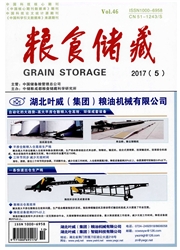

 中文摘要:
中文摘要:
采用试验观测的方法,对钢板仓仓储小麦分别进行不通风、两阶段和三阶段降温通风研究和分析。研究发现,相对于秋季两阶段通风而言,夏季增加一个通风阶段更有利于提高降温效果。在为期两年的试验中,在夏季合适的气温条件下,用较小的通风量进行降温通风,小麦有足够的时间与温度低于24℃的空气接触达到冷却的目的。然而,由于夜间空气温度低、湿度大的特点导致粮食最终温度高于24℃,同时由于送风湿度大的原因,粮食的水分也会相应增大。
 英文摘要:
英文摘要:
Two aeration strategies were compared with'non--aeration in field tests of stored wheat in a steel stlo. The effect of different ventilation modes on the temperature control of stored bulk grain was also analyzed. An additional summer aeration cycle before the usual two autumn cycles produced better temperatures drop for stored bulk grain. Both aeration strategies yielded much better temperatures for insect control than did in non--aeration bin. In two years of tests for wheat aeration with low airflow rates in summer there were sufficient air with temperatures below 24℃ to cool the grain. However, airflow with high humidity during these nighttime periods of low temperatures resulted in final temperatures higher than 24℃ due to the heating effect when the grain was slightly rewetted by the high humidity air.
 同期刊论文项目
同期刊论文项目
 同项目期刊论文
同项目期刊论文
 期刊信息
期刊信息
